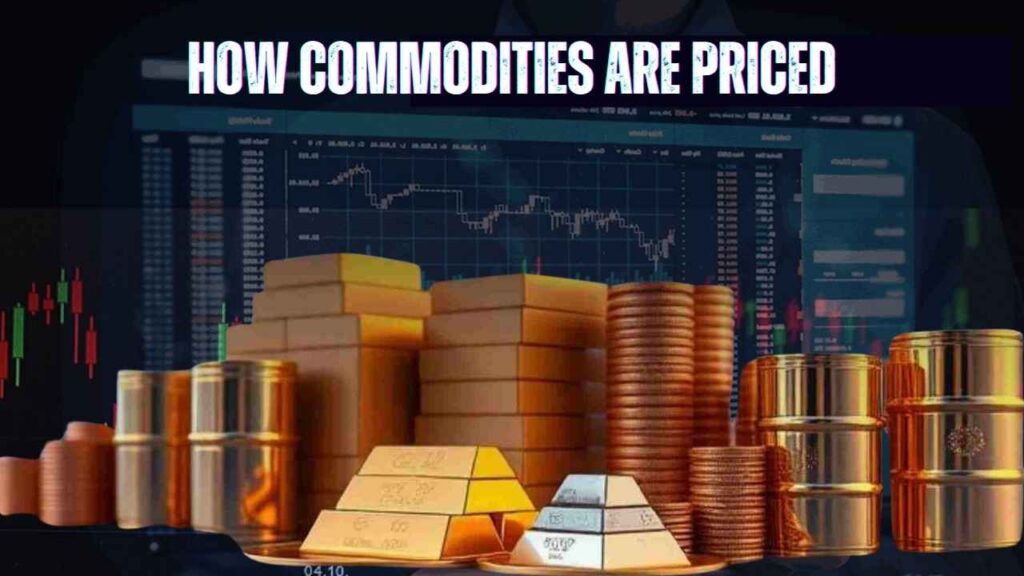Commodity pricing is a multifaceted process governed by a wide array of factors from supply and demand to geopolitics and currency fluctuations. For those entering commodity markets or wanting to diversify their investment portfolio, knowing the underlying dynamics of commodity pricing is essential. This blog post explores the most significant factors that determine how commodities are priced, the dynamics of futures and spot markets, and why prices can change so dramatically.

The Basics of Commodity Pricing
Commodities are primary agricultural products or raw materials which are available to purchase and sell. They represent classes such as:
- Energy: Crude oil, natural gas, coal.
- Metals: Gold, silver, copper, platinum.
- Agricultural Products: Wheat, corn, soybeans, coffee.
- Soft Commodities: Cotton, sugar, cocoa.
The value of such commodities is generally decided through a process that consists of both physical demand and supply forces and intricate financial instruments such as futures contracts.
Key Factors Influencing Commodity Prices
1. Supply and Demand
- Supply Factors:
Production levels, weather patterns, technological developments, and geopolitical occurrences influence the supply. An example is a drought that lowers crop output while geopolitical issues in oil-producing countries could derail production. - Demand Factors:
Global economic prospect, consumption habits, and industrial demand determine commodity prices. Economic growth tends to drive demand for metals and energy, pushing prices higher.
2. Futures Markets and Price Discovery
- Futures Contracts:
Commodities are usually traded through futures contracts on exchanges, including the Multi Commodity Exchange (MCX) and National Commodity and Derivatives Exchange (NCDEX) in India. The contracts enable buyers and sellers to lock in a price today for a future transaction. - Price Discovery:
The price discovery process in futures markets captures the aggregate belief of market participants. The price at which buying and selling is done is decided by the interaction between buyers and sellers based on all available information.
3. Currency Fluctuations
- Exchange Rates:
Because so many commodities are denominated in U.S. dollars, changes in currency values can affect commodity prices. A higher dollar generally makes commodities more costly to buyers with other currencies, which can reduce demand and prices.
4. Inflation and Interest Rates
- Inflation Impact:
Commodities are often seen as an inflation hedge. As inflation rises, the prices of commodities may increase, as they are tangible assets that tend to retain value. - Interest Rates:
Changes in interest rates can influence commodity prices indirectly. Lower interest rates reduce the cost of carrying inventory and can boost demand by making financing cheaper.
5. Geopolitical and Environmental Factors
- Political Stability:
Geopolitical instability or conflicts in key producing regions can disrupt supply, leading to price spikes. - Environmental Events:
Natural disasters, adverse weather conditions, and climate change can significantly reduce supply, especially in agricultural commodities, driving up prices.
How Are Commodity Prices Quoted?
Commodity prices are quoted in either the spot market or the futures market:
- Spot Market Prices:
The current price at which a commodity can be bought or sold for immediate delivery. - Futures Prices:
Prices agreed upon in futures contracts for delivery on a specified future date. These prices represent the market’s expectations and are influenced by factors like storage costs, interest rates, and anticipated supply and demand.
Why Understanding Commodity Pricing Matters
It is important to know how commodities are priced for several reasons:
- Investment Decisions:
Investors can make informed choices when they know the drivers of price change in commodities. - Risk Management:
Hedging techniques usually depend on a thorough knowledge of commodity pricing to offset risks due to erratic price fluctuations. - Economic Indicators:
Commodity prices are leading indicators of economic well-being. For instance, increases in oil prices can presage greater economic activity and inflation.
Final Thought
Commodity prices are a dynamic function that represents the interaction among supply, demand, market sentiment, currency movement, and geopolitics. Whether you’re an investor looking to diversify your portfolio or a trader aiming to capitalize on market trends, understanding how commodities are priced can enhance your decision-making process. Keep an eye on global developments, stay informed on market trends, and consider integrating commodity exposure into your investment strategy as a hedge against inflation and economic uncertainty.
Frequently Asked Questions (FAQ)
Q1. What factors most influence commodity pricing?
A: Commodity pricing is primarily influenced by supply and demand, futures market dynamics, currency fluctuations, inflation, interest rates, and geopolitical events.
Q2. How do futures contracts help in price discovery?
A: Futures contracts allow market participants to agree on a price for a commodity at a future date, reflecting collective expectations about future supply and demand, which is key to the price discovery process.
Q3. Why are commodities considered an inflation hedge?
A: Commodities, as tangible assets, tend to rise in price along with inflation, helping investors protect their purchasing power during periods of rising prices.
Q4. How do geopolitical events affect commodity prices?
A: Political instability or conflicts in commodity-producing regions can disrupt supply chains, leading to reduced availability and higher prices in the market.
Q5. What is the difference between spot and futures market prices?
A: Spot prices represent the current market price for immediate delivery, while futures prices are set for transactions that will occur at a future date, influenced by storage costs, interest rates, and anticipated market conditions.










